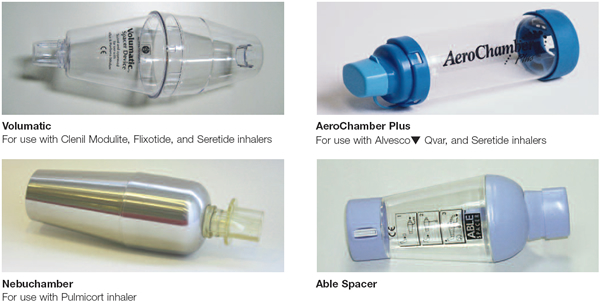Inhaled medicines containing corticosteroid
Licensed doses and differences in potency between different inhaled corticosteroids; advice for use with spacer device.
Post-publication note, July 2018
This information was correct at time of publication; the updated Summary of Product Characteristics for each medicine should be consulted for the latest advice.
Article date: July 2008
Inhaled corticosteroids are anti-inflammatory medicines that are licensed for the management of asthma and chronic obstructive pulmonary disease. 5 corticosteroids are currently available as pressurised metered-dose inhalers: beclometasone; budesonide; ciclesonide; fluticasone; and mometasone; some are available as nebuliser suspensions for inhalation.
Licensed indications
Asthma
All single-constituent inhaled corticosteroids are licensed for the treatment of asthma, and they should be prescribed in accordance with product information (ie, summary of product characteristics) and the British Guideline on the Management of Asthma from the British Thoracic Society and Scottish Intercollegiate Guideline Network.
Not all inhaled corticosteroids are licensed for use in children, particularly high-strength and high-potency formulations;[footnote 1] [footnote 2] more information is available in the BNF for Children.
The MHRA has previously issued advice about corticosteroid safety.[footnote 3] [footnote 4] Different inhaled corticosteroids have different potencies. The dose needed for disease control with fluticasone propionate may be lower than that needed with some other inhaled corticosteroids.
Some inhalers contain a corticosteroid and a long-acting beta2 agonist (LABA) in a fixed-dose combination. All fixed-dose combination inhalers are licensed for the management of asthma.
COPD
Inhaled corticosteroids are not licensed for use alone in the treatment of COPD. However, treatment guidelines suggest that regular use of an inhaled corticosteroid (in addition to bronchodilator therapy) can reduce the frequency of exacerbations for patients with severe COPD (ie, FEV1 <50% predicted) who have a history of repeated exacerbations.
Please refer to product information for the specific indications and posology of individual products. Seretide 500 Accuhaler and Symbicort 200/6 or 400/12 turbohaler are licensed for the management of both asthma and COPD.
Different potencies of CFC-free beclometasone inhalers
Qvar and Clenil Modulite▼ are CFC-free pressurised metered-dose inhalers that contain beclometasone diproprionate. They have different potencies because of their different formulations, which may have implications for both safety and efficacy. Qvar has extrafine particles, is more potent than traditional CFC-containing inhalers, and is about twice as potent as Clenil Modulite▼.
Advice for healthcare professionals includes:
- prescribe CFC-free beclometasone metered-dose inhalers by brand name to reduce the risk of dosing errors
- pharmacists are reminded that for any generic prescription for beclometasone, they should establish whether a CFC-free product is required and if so, which brand should be dispensed
- clenil modulite▼ may be used in children (with the Volumatic spacer device) and adults; Qvar is not recommended for use in children
CFC-free beclometasone and formoterol
Fostair▼ is a CFC-free, fixed-dose combination of beclometasone and formoterol, which is licensed for the management of asthma in patients aged 18 years or older. Similar to Qvar, Fostair▼ contains an extrafine formulation of beclometasone and is more potent than traditional CFC-containing beclometasone inhalers.
The inhaled-corticosteroid component of Fostair▼ is about twice the potency of traditional CFC-containing inhalers, which should be taken into account when switching patients from a non-ultrafine preparation. The dose of beclometasone dipropionate in Fostair▼ should be lower than non-extrafine formulations of beclomethasone dipropionate and will need to be adjusted to the individual needs of the patient.
Spacers
Spacers are chambers that can help patients use pressurised metered-dose inhalers more effectively and safely by maximising the amount of medicine that reaches the lung while minimising the amount deposited in the mouth and throat. Spacers are useful for children, patients who need high doses of inhaled corticosteroids, and patients who find it difficult to coordinate actuation of an inhaler with inspiration.
Some of the most commonly used spacers are illustrated below:

Image of four different spacer devices.
Advice for healthcare professionals includes:
- spacers should not be regarded as interchangeable: patients who use a spacer with their inhaler should use the spacer device named in the Summary of Product Characteristics (where specified by name)
- patients whose asthma is well-controlled and who are using a spacer should always use the same type of spacer and not switch between spacers. Different spacers may deliver different amounts of inhaled corticosteroid, which may have implications for both safety and efficacy
Article citation: Drug Safety Update Jul 2008; Vol 1, Issue 12: 8
Moreinformation:
Summaries of product characteristics on the electronic Medicines Compendium
MHRA asthma management
Evidence on the management of asthma and COPD is summarised by the National Prescribing Centre in its MeReC Stop Press and MeReC Rapid Review blogs